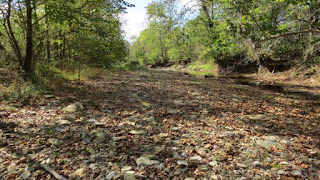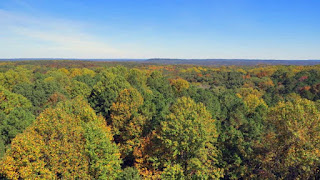First of all, Happy Halloween to everyone!
Today I will post the remaining photos from Indiana. I'll begin with pictures of my sister and I geode hunting in a very remote creek.
Local residents....
Then we headed back into the Hoosier National Forest....
Of course, we had to climb the fire tower....
One more geology stop....
The river was not running, but the photo below shows the end of the river.
A short hike brought us to an awesome sink hole pond....
There were caves, but we did not try to get in them.
The photo below is for perspective. The arrow points to my sister standing on the opposite ridge. The next photo below shows a close up.
Saturday, October 31, 2015
Friday, October 30, 2015
Shoals, Indiana Area Photos
As usual while on vacation with my sister, Diana, we both took lots of photos. It is one of the things we love doing with each other. I have two more sets of photos to post, including the pictures below.
Jug rock is located on the edge of town. Jug Rock is a natural geological formation located in the valley of the East Fork of the White River. It is composed of sandstone, and is the largest free-standing table rock formation in the United States east of the Mississippi River. It is part of the Mansfield formation, laid down in the Pennsylvanian geological epoch, roughly 325 to 286 million years ago. Erosion along fracture lines separated it from a nearby cliff.
Next we stopped at Overlook Park....
Then we drove southeast of town to Hindostan Falls. The town of Hindostan was founded at the falls of the East Fork of the White River in 1816. The settlement sat along the original stagecoach route and was one of the only roads in the new state of Indiana, which had been a territory until 1816. By 1820, it was the largest community in what was then still Daviess County and the most promising town on the White River.
By 1820, about 1,200 people lived in the new town, making it one of the largest settlements in frontier Indiana. Many lived on houseboats on the White River. The surge of population toward new land on the Indiana and Illinois frontiers, as well as Hindostan's location along the stagecoach route, meant that it was constantly open to carriers of disease. Disease eventually destroyed the town. An epidemic of yellow fever or cholera broke out in Hindostan in 1820. Water- and insect-borne illnesses were the bane of many towns on the Midwestern frontier. Situated along rivers for the purpose of easy transportation, towns were often built on flood plains that bred insects in huge numbers. The ferocity of the epidemic that struck Hindostan, however, caused the population to succumb to disease or abandon the area. The falls is shown below.
Our next destination was a covered bridge, located northwest of Shoals.
Just up river from the covered bridge we stopped at a damn....
We walked down a stairway to the beach....
Then we walked onto the cement structure located at the damn. The photo below shows a view looking straight down....
On the way back to Shoals, we stopped at a small park that used to be the Trinity Springs resort.
The house we rented was located next to a church. We had to drive through a hole in a hedge to reach our very remote rental.
There was a porch off the second story. The photo below shows the hill located next to the house.
The pictures below show Diana and I playing with the house and the antiques that were located all over the house.
CITES:
https://en.wikipedia.org/wiki/Jug_Rock
https://en.wikipedia.org/wiki/Hindostan_Falls,_Indiana
Jug rock is located on the edge of town. Jug Rock is a natural geological formation located in the valley of the East Fork of the White River. It is composed of sandstone, and is the largest free-standing table rock formation in the United States east of the Mississippi River. It is part of the Mansfield formation, laid down in the Pennsylvanian geological epoch, roughly 325 to 286 million years ago. Erosion along fracture lines separated it from a nearby cliff.
Next we stopped at Overlook Park....
Then we drove southeast of town to Hindostan Falls. The town of Hindostan was founded at the falls of the East Fork of the White River in 1816. The settlement sat along the original stagecoach route and was one of the only roads in the new state of Indiana, which had been a territory until 1816. By 1820, it was the largest community in what was then still Daviess County and the most promising town on the White River.
By 1820, about 1,200 people lived in the new town, making it one of the largest settlements in frontier Indiana. Many lived on houseboats on the White River. The surge of population toward new land on the Indiana and Illinois frontiers, as well as Hindostan's location along the stagecoach route, meant that it was constantly open to carriers of disease. Disease eventually destroyed the town. An epidemic of yellow fever or cholera broke out in Hindostan in 1820. Water- and insect-borne illnesses were the bane of many towns on the Midwestern frontier. Situated along rivers for the purpose of easy transportation, towns were often built on flood plains that bred insects in huge numbers. The ferocity of the epidemic that struck Hindostan, however, caused the population to succumb to disease or abandon the area. The falls is shown below.
Our next destination was a covered bridge, located northwest of Shoals.
Just up river from the covered bridge we stopped at a damn....
We walked down a stairway to the beach....
Then we walked onto the cement structure located at the damn. The photo below shows a view looking straight down....
On the way back to Shoals, we stopped at a small park that used to be the Trinity Springs resort.
The house we rented was located next to a church. We had to drive through a hole in a hedge to reach our very remote rental.
There was a porch off the second story. The photo below shows the hill located next to the house.
The pictures below show Diana and I playing with the house and the antiques that were located all over the house.
CITES:
https://en.wikipedia.org/wiki/Jug_Rock
https://en.wikipedia.org/wiki/Hindostan_Falls,_Indiana
Subscribe to:
Comments (Atom)


































































